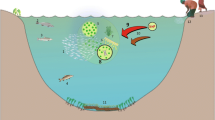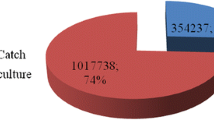Abstract
Aquaculture is a major supplier of animal protein for Bangladesh’s population, and the Mymensingh division is a major contributor to finfish aquaculture, producing 43% of the total pond pangasius and 9% of the total amount of tilapia (figures from 2018). We conducted a finfish farmer survey covering Netrokona, Jamalpur and Mymensingh districts to understand current finfish farming practices and identify factors that drive farmers in their species choice between pangasius or tilapia cultivation. We found that most finfish farmers in Mymensingh are experienced practitioners and practise polyculture with a range of stocking densities for each species. Using an economic model of polyculture practice, we have shown that over a production cycle, pangasius gain body mass at a rate nearly 4 times greater than that for tilapia, resulting in substantially larger revenues and providing a strong incentive for their culture. High levels of tilapia aquaculture likely persist due to their short production cycle and an associated decreased economic risk due to crop loss from disease, both factors providing a strong incentive for their culture. Our findings also indicate production yield differences through different species selection in polyculture systems. For example, co-culturing pangasius, tilapia and carp together was less productive than co-culture of pangasius with tilapia. Furthermore, higher yields of tilapia were obtained when co-cultured with carp compared with pangasius, the reasons for which are not known and warrant further investigation. Our study uses information provided by finfish farmers to produce a useful guide on fish species choices to maximise production yields, and therefore food production, from their ponds.

taken from DoF, 2018)




Similar content being viewed by others
Data availability
Anonymised data available on request to corresponding author.
Code availability
Not applicable
References
Alam M (2019) Pros and cons of international aquaculture certification in relation to pangasius and tilapia export from Bangladesh to global market. PhD Thesis, Department of Aquaculture, Bangladesh Agricultural University, Mymensingh pp. 228.
Alam F, Khan A, Huq ASMA (2012) Technical efficiency in tilapia farming of Bangladesh: a stochastic frontier production approach. Aquacult Int 20:619–634
Ali H, Haque MM, Belton B (2013) Striped catfish (Pangasianodon hypophthalmus, Sauvage, 1878) aquaculture in Bangladesh: an overview Aquaculture Research, 44:950-965
Anwar J, (2011) Market study on some freshwater farmed fish: tilapia and pangas (Mekong river catfish), USAID. pp. 141.
Belton B, Karim M, Thilsted S, Murshed-E-Jahan K, Collis W, Phillips M (2011) Review of aquaculture and fish consumption in Bangladesh. Studies and Reviews 2011-53.
DoF (2017) Yearbook of Fisheries Statistics of Bangladesh 2016–2017. Fisheries Resource Survey System 34:129
DoF (2018) Yearbook of Fisheries Statistics of Bangladesh 2017–2018. Fisheries Resource Survey System 35:44–54
FAO (2019) Fisheries and aquaculture software. FishStatJ – Software for Fishery and Aquaculture Statistical Time Series. http://www.fao.org/fishery/. Accessed 20 December 2019
Haque MM, Alam MR, Alam MM, Basak B, Sumi KR, Belton B, Jahan KME (2015) Integrated floating cage aquaponics system (IFCAS): an innovation in fish and vegetable production for shaded ponds in Bangladesh. Aquaculture Reports 2:1–9
RStudio Team (2016) RStudio: Integrated Development for R. RStudio Inc, Boston, MA
Shamsuzzaman MM, Islam MM, Tania NJ, Al-Mamun MA, Barman PP, Xu X (2017) Fisheries resources of Bangladesh: present status and future direction. Aquaculture and Fisheries 2(4):145–156
Tran K, Verdegem M, Wolkenfelt B, Chadag M, Verreth J (2019) The relation between farming practices and tilapia production in small-scale fish farms in Bangladesh. Penang, Malaysia: CGIAR Research Program on Fish Agri-Food Systems. Program Report: FISH-2019-06.
Acknowledgements
The authors would like to acknowledge the cooperation and assistance of the fish farmers for taking part in the mobile app-based survey.
Funding
This work was funded by the Newton Fund (delivered by the Biotechnology and Biological Sciences Research Council and the Economic & Social Research Council, BB/N00504X/1) and the Department for International Development, under the Newton Fund Global Research Partnership in Aquaculture programme awarded to CRT and DB.
Biotechnology and Biological Sciences Research Council,BB/N00504X/1,David Bass ,BB/N00504X/1,Charles Tyler ,Newton Fund
Author information
Authors and Affiliations
Corresponding author
Ethics declarations
Ethics approval
Not applicable
Conflict of Interest
The authors report no conflicts of interest from this publication.
Additional information
Publisher's note
Springer Nature remains neutral with regard to jurisdictional claims in published maps and institutional affiliations.
Charles R. Tyler and David Bass are the joint senior authors.
Handling editor: Gavin Burnell
Supplementary Information
Below is the link to the electronic supplementary material.
Rights and permissions
About this article
Cite this article
Heal, R., Haque, M.M., Hasan, N.A. et al. Understanding the economic and farming practices driving species selection in aquaculture within the Mymensingh division of Bangladesh. Aquacult Int 30, 773–789 (2022). https://doi.org/10.1007/s10499-021-00818-y
Received:
Accepted:
Published:
Issue Date:
DOI: https://doi.org/10.1007/s10499-021-00818-y




